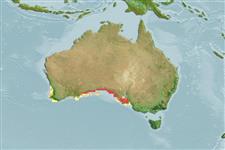>
Syngnathiformes (Pipefishes and seahorses) >
Syngnathidae (Pipefishes and seahorses) > Syngnathinae
Etymology: Stigmatopora: Greek, stigma = mark, signal + Greek, poros = porous (Ref. 45335); narinosa: Name from Latin 'naris' for nostril, broadnosed, after the wide and distinctive spatulate shape of its snout..
Environment: milieu / climate zone / depth range / distribution range
Ecologia
marino demersale; distribuzione batimetrica 1 - 5 m (Ref. 75062). Temperate
Distribuzione
Stati | Aree FAO | Ecosystems | Presenze | Point map | Introduzioni | Faunafri
Eastern Indian Ocean: South Australia.
Size / Peso / Age
Maturity: Lm ? range ? - ? cm
Max length : 15.0 cm TL maschio/sesso non determinato; (Ref. 75062)
Short description
Morfologia | Morfometria
This species differs from its congeners having an indistinct trunk and tail ridges, particularly lateral trunk ridge, in fresh specimens; the lateral trunk ridge terminates 1.5 body rings posterior to anal ring; short, wide and slightly elevated snout; 9 sub-dorsal tail rings; distinct
banded pattern in both live and preserved specimens (Ref. 75062).
All specimens were collected or photographed in sheltered shallow open water at 1-5 m depth over a substrate of a mosaic of patches of brown algae, with Posidonia or Zostera. It appears to have a very limited inshore distribution along patches of moderate energy coastlines with low turbidity and a broken vegetation pattern of seagrass and brown algae. The restricted inshore habitat may be particularly vulnerable to pollutants or exotic marine species. The eggs of this species are deposited in two layers, a basal and then an external layer. A specimen with the greatest recorded number of eggs had 3 staggered rows of 64 basal membranous egg compartments on the tail, with the basal layer of eggs covered by a membrane with matching rows of egg pouches; the second layer with 34 eggs within the brood pouch folds resulted in a total of 98 eggs. Total lengths of larvae at hatching is 1.8 cm (vs. 1.3 cm in S. nigra and 3.2 cm in S. argus. Males of this species have extended brood
patches from December to March, and juveniles < 9.0 cm are seen from December to March. Males also can mature at 11.3 cm. The maximum recorded brood was 98 eggs which was far greater than that recorded by for S. nigra which is approximately 25 and for S. argus with 41 eggs (Ref. 75062).
Life cycle and mating behavior
Maturità | Riproduzione | Deposizione | Uova | Fecundity | Larve
Male carries the eggs in a brood pouch (Ref. 205).
Browne, R.K. and K. Smith, 2007. A new pipefish, Stigmatopora narinosa (Syngnathidae) From South Australia. Memoirs of Museum Victoria 64:1-6. (Ref. 75062)
IUCN Red List Status (Ref. 130435)
Threat to humans
Harmless
Human uses
Informazioni ulteriori
Age/SizeAccrescimentoLength-weightLength-lengthLength-frequenciesMorfometriaMorfologiaLarveDinamica popolazioni larvaliReclutamentoAbbondanzaBRUVS
BibliografiaAcquacolturaProfilo di acquacolturaVarietàGeneticaElectrophoresesEreditarietàMalattieElaborazioneNutrientsMass conversion
CollaboratoriImmaginiStamps, Coins Misc.SuoniCiguateraVelocitàModalità di nuotoArea branchialeOtolithsCervelliVista
Strumenti
Special reports
Download XML
Fonti Internet
Estimates based on models
Preferred temperature (Ref.
123201): 16.3 - 18, mean 17.4 °C (based on 81 cells).
Phylogenetic diversity index (Ref.
82804): PD
50 = 0.5625 [Uniqueness, from 0.5 = low to 2.0 = high].
Bayesian length-weight: a=0.00037 (0.00016 - 0.00085), b=3.18 (2.99 - 3.37), in cm total length, based on LWR estimates for this (Sub)family-body shape (Ref.
93245).
Trophic level (Ref.
69278): 3.3 ±0.4 se; based on size and trophs of closest relatives
Resilienza (Ref.
120179): Alto, tempo minimo di raddoppiamento della popolazione meno di 15 mesi (Preliminary K or Fecundity.).
Fishing Vulnerability (Ref.
59153): Low vulnerability (10 of 100).
